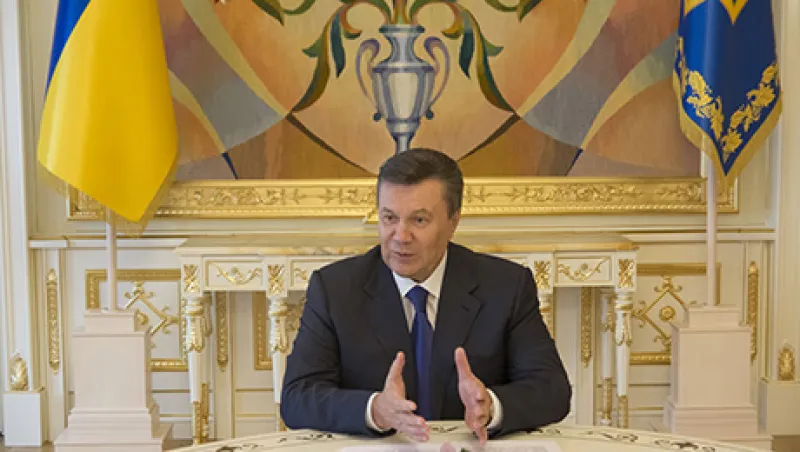Would you buy a bond yielding 10 percent that matures three months from now, or 13 percent paper that matures in August 2015? They both sound like an alluring proposition, except for the issuer: the sovereign state of Ukraine.
Street protesters in Kiev and other cities have faced off with the government of President Viktor Yanukovych for the past two months while Russia and the European Union have jostled behind the scenes for influence over the nation of 46 million on which they both border. As a result, Ukraine’s financial outlook has taken its own twists and turns. These leave the dwindling but dedicated band of emerging-markets bond investors guessing on how to play the unfolding story, and the rest of the world wondering whether the country may soon add default to its long list of challenges.
Ukraine faces a financial mess along with its political one. World prices for steel, its biggest export, have fallen by half since the Chinese economy started to slow in 2011. The national currency, the hryvnia, is pegged to the dollar and heavily overvalued as a result. Budget deficits are large and growing, exceeding 5 percent of gross domestic product in 2013. Successive governments, going back to the days of Yanukovych’s imprisoned archrival, former prime minister Yulia Tymoshenko, have refused to meet the International Monetary Fund’s terms for an adjustment package — including reducing massive subsidies on natural gas prices.
That has left the state to borrow in private markets on increasingly onerous terms. Some $6 billion of a total $40 billion in external debt comes due for repayment this year. President Vladimir Putin of Russia promised an easy, if short-term, solution in mid-December. Two weeks after Yanukovych refused to sign a so-called association agreement with the EU, sparking an uproar among his population, he traveled to Moscow. There, Putin summarily announced that Russia would tap one of its reserve funds to buy $15 billion in new Ukrainian bonds over the next two years and cut its price for gas to the struggling neighbor by one third. Russia bought an initial $3 billion tranche in early January, and the market rejoiced. The yield on the country’s August 2015 outstanding bond issue plunged from 17 percent to 10.75 percent, according to Investing.com.
But Putin’s largesse could not buy peace in Ukraine. The death of at least two protesters in fighting with police on January 22 escalated the crisis anew, prompting anti-Yanukovych groups to occupy government buildings in as many as a dozen cities. Yanukovych responded by firing his prime minister, Mykola Azarov, and offering the post to Tymoshenko lieutenant Arseniy Yatsenyuk, who turned it down and demanded the president’s resignation instead. Ukrainian opposition leader and champion boxer Vitali Klitschko was offered the office of deputy prime minister. He reportedly rejected the offer and demanded the presidential elections be moved up to this year from 2015. An uneasy calm settled over the conflict in early February, with Yanukovych taking a few days off for alleged sick leave, then flying to Sochi for another visit with Putin just before the Winter Olympics got under way.
Putin says his financial bailout offer still stands. “Regarding your question whether we will review our agreements on loans and the energy sector if the opposition will take power [in Ukraine]: No, we will not,” the Russian leader told reporters after a summit with EU leaders in Brussels on January 28. But a second, $2 billion bond issue scheduled for late January was quietly shelved. Russian finance minister Anton Siluanov hinted that further assistance would be linked to Ukraine’s paying back debts to Russia for natural gas, which he estimated at $2.7 billion. “We will fulfill what we have promised to Ukraine, but we would like the Ukrainian side to comply with the obligation that it has committed to,” he told journalists while Yanukovych was meeting Putin at Sochi. These qualifications sapped investor confidence again, and yields on Ukraine’s 2015 bond issue rebounded to 16 percent.
Western powers put something resembling a financial offer of their own on the table at a February 1–2 conference in Munich attended by Russian and some Ukrainian opposition leaders. Catherine Ashton, the EU’s high representative for foreign affairs, told the Wall Street Journal that Europe and the U.S. were working on a relief package for Ukraine that “won’t be small,” provided Yanukovych appoints a politically neutral technocratic government that will start on IMF-style reforms. An aide to U.S. secretary of state John Kerry, who was also on the scene, echoed that a “big carrot” was in the works.
Bond investors and analysts are divided on how they should react to this maelstrom of events. JPMorgan Chase & Co. recommended shifting to a “tactical overweight” on the latest market jitters in a research note released January 28. “The most likely scenario is that a relatively peaceful winding-down of protests will gradually emerge,” London-based JPMorgan analysts Nicolaie Alexandru-Chidesciuc and Jonny Goulden wrote. They also took Putin more or less at his word that Russia will continue its support, even in the face of political compromise. “Russia showed that it has a strategic interest in Ukraine when it agreed on the $15 billion bond deal and the gas deal,” they concluded.
A less optimistic view comes from Régis Chatellier, a global emerging-markets senior credit strategist in Société Générale’s London office. The Ukrainian opposition has “radicalized a great deal,” to the point where only Yanukovych’s ouster will be acceptable on the streets, he says. But that outcome may prove unacceptable to the silent majority of Ukrainians, concentrated in the country’s Russian-speaking east and south, who elected Yanukovych in 2010, not to mention to Russia itself, he adds. “The risk-reward calculation is not exactly very interesting at the moment,” Chatellier says.
Ukraine’s longer-duration bonds trade a bit tighter than those due for payment over the next 18 months, indicating some faith in the struggling nation’s future beyond the current standoff. Paper maturing in 2017 yields a relatively modest 10.2 percent. Total public debt remains at a manageable 37 percent of GDP, according to the CIA’s World Factbook. A few bold reforms, particularly the gradual phasing out of gas subsidies, could go a long way toward repairing public finances and squeezing distortions out of the economy. “Ukraine is more of a serious liquidity problem than a solvency problem,” says Blaise Antin, managing director and head of sovereign research at TCW Group, a Los Angeles–based fund manager.
One way or another, money has a big role to play in resolving the current Ukrainian crisis.






